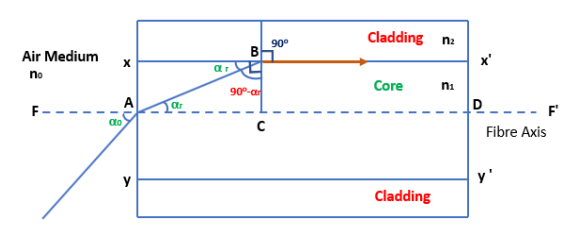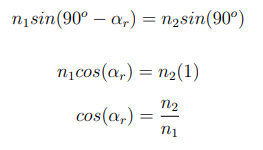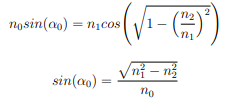Acceptance angle & Numerical Aperture
Accptence angle
A light signal incident at an angle α0 at point A and goes along the path AB. After total internal reflection on the core cladding boundary, it will go along BD.

Figure 1. Total internal reflection
Lets draw a perpendicular BC on AD. ∠BCA = 90o, ∠BAC = α0 and ∠ABC = αr.
Lets apply Snell’s Law at the medium 1 and core boundary.
 ------------------ (1)
------------------ (1)Let’s apply Snell’s law at the core and cladding boundary:


Generally the medium 1 is Air for which n0=1. Hence equation can be written as

Where θa is the acceptance angle.
Acceptance angle (θa) is the maximum angle at which a ray of light can enter a optical fiber and will be total internally reflected in the core medium.
Numerical aperture
Numerical Aperture is the light gathering capability of the optical fiber. Light collecting capacity of the fiber is expressed in terms of acceptance angle using the terminology ’Numerical Aperture’.

It should be noted that the numerical aperture of a fiber i.e., its light collecting capacity is effectively dependent only on the refractive indices of the core and cladding materials and is not a function of the fiber dimensions.
Fractional Index Change
It is defined as the ration between the difference between refractive index of core and cladding to the refractive index of the core.

Relation between Numerical Aperture (NA) and Fraction Index Change (∆)





For most of the fibers, the refractive indices of core and cladding are very close to each other. So, n1 ≈ n2 Hence,
